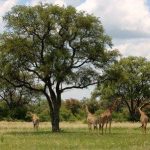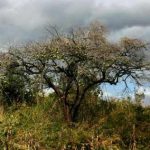TREE LIFE
June 2004
Annual subs are now overdue. Prompt payment would be appreciated.
$5000 for Tree Life by email or $10000 by post.
MASHONALAND CALENDAR
Saturday 5TH June. Botanic Garden Walk. Meet in the car park at 10.45am for 11am.
Sunday 20th June Our outing this month is to the home of Helen and Albert Grey near Darwendale. Please bring your lunch and your chair. We will meet at 9.30am
Saturday 26th June. Mark’s walk will be at the home of Dr Peter Iliff at 7, Ernie’s Lane, Monavale.
Saturday 3rd July. Bot Garden Walk.
Tom will be away for the next three months but Meg Coates Palgrave has kindly offered to lead some of the walks in his absence.
MATABELELAND CALENDAR
Nothing has been arranged for June.
BOTANIC GARDEN WALK: 6 APRIL 2004
The main subject of the evening was the Sapotaceae.
The features of this family are as follows:
woody plants;
a mainly tropical distribution;
milky latex (sometimes reluctantly produced);
leaves simple and entire;
leaves arranged spirally (and often obovate);
young leaves and stems have brownish hairs; (this is very characteristic);
stipules rarely present;
flowers actinomorphic and bisexual;
fruits fleshy and indehiscent and (as Tom remarked) often edible.
World-wide there are 975 species in 53 genera (per Mabberley). Many have edible fruits (e.g. the sapote of the W. Indies), produce oils or timber and some are the source of gutta-percha.
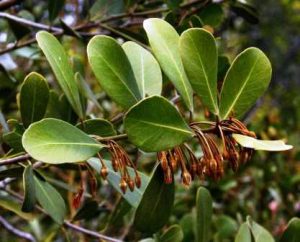
Manilkara concolor. Photo: Bart Wursten. Source: Flora of Zimbabwe
Our first tree was Manilkara concolor. This is a rare species in Zimbabwe, Tom disclosed that it was found in Gona-re-Zhou in a dry stream south of the Runde River. This species has more or less concolorous leaves (i.e. the colour is the same on both sides). However, we later saw Manilkara discolor. This species has very markedly discolorous leaves which are silvery-grey beneath and glossy dark green above; a very striking combination. M. discolor occurs in forest outliers (e.g. Murahwa’s Hill) and forest edges and it can be a very large tree, attaining 50 metres.
On to the genus Mimusops. The first tree we looked at was labelled Mimusops obtusifolia, but Tom explained that there is some doubt about this and it may simply be the common M. zeyheri. M. obtusifolia is another rather local species in Zimbabwe, having been recorded from the Eastern and Southern divisions of Zimbabwe. It also occurs quite widely in other parts of Africa.
None of the 3 species mentioned so far in this write-up have been seen by me in the wild thus suggesting that they are not particularly common. The next species, however, Mimusops zeyheri, is a well-known tree of riverine forest and rocky hills. It has glossy dark green leaves and is usually evergreen. It has the typical brown-hairiness of the Sapotaceae. Although it produces milk, it may not do so on occasions and this can be confusing. Conceivably it could be confused with trees in the Moraceae (e.g. a species of fig) but the Mimusops lacks stipules.
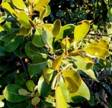
Sideroxylon inerme. Photo: Mark Hyde. Source: Flora of Zimbabwe
Sideroxylon inerme is primarily a coastal species occurring on dunes but it does also occur inland and just reaches Zimbabwe in the extreme SE where it occurs on anthills in Gona-re-Zhou. It has the typical brown-hairiness of the family. Ours is subsp. diospyroides, which implies it should resemble a Diospyros, which I think it actually does. Another feature of this species is that it flowers and fruits on the old wood.
Pouteria adolfi-friedericii (formerly in the genus Aningeria) is extremely rare in Zimbabwe, occurring only in the Honde valley in the forest at the base of the Mtarazi Falls. There, however, it is the main tree and has extremely large buttresses. Once again, the rustiness of the leaves was clearly visible.
Inhambanella henriquesii is another very rare Zimbabwean tree (again, a wide distribution in Africa). Although not confined to it, it does occur in the Chirinda Forest where it can be found by its striking red flush of its young leaves. The leaves are crowded at the apex of the branches and are obovate. The species has a large, edible fruit.
On next to the two species of Chrysophyllum. C. gorungosanum is the main tree (with Craibia brevicaudata) of Chirinda Forest, attaining 50 metres. It is also quite widespread in the eastern Highlands. It has narrow, obovate leaves with a distinctly silvery underside and brownish indumentum.
Chrysophyllum viridifolium, on the other hand, is much rarer, occurring in Chirinda Forest only. We barely had time to look at this as night was falling fast and it was specially dark in the forest sections. It has a much smaller leaf which is shiny and green; it doesn’t look like a typical Sapotaceae.
Pachystela brevipes has a trunk with many flutes. Once again we saw the milky latex and obovate leaves. Like the Sideroxylon it also exhibits cauliflory, bearing its flowers on the old wood.
It is interesting that so many of the species we saw in this family are very local in Zimbabwe; so many seem to be confined to one or two of our Eastern Districts forests or just reach Zimbabwe in the south and east.
Once again, our thanks go to Tom for his inspiring guidance.
-Mark Hyde
MAZVIKADEI DAM, BANKET: 18 APRIL 2004
Our April outing was a relatively long-distance one to Mazvikadei Dam, near Banket. We assembled at the sumptuous R Davies cottage, the use of which we had obtained through Adele, and then drove round to the dam wall, an area of interest which we had recced the day before.
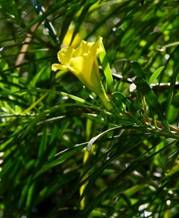
Thevetia peruviana. Photo: Bart Wursten. Source: Flora of Zimbabwe
On the way, we stopped by a line of trees adjacent to the road to have a look at a specimen of Thevetia peruviana. This is a very commonly-planted garden plant with dark green glossy linear leaves and large-ish yellow flowers; Harare gardens are absolutely full of it. It is an Apocynaceae and is therefore milky but unlike most of our native species the leaves are arranged spirally.
The question as to whether it ever escapes into the wild is difficult to answer. If I recall correctly, Bob Drummond had recorded it on his list of weeds and we have seen it growing in riverine forest by the Angwa River looking very well naturalised. At this site, it was hard to tell if it looked naturalised but it was growing along a roadside and could easily have been planted by some owner in the past.
At the same spot, some other species caught our eye, namely a fine fruiting specimen of Pericopsis angolensis and Acacia amethythophylla with its flowers arranged in large panicles.
At the dam wall we parked up in the top car-park and looked at the trees below while admiring the view over the Dam. The altitude of Mazvikadei is noticeably lower than Harare; for example the dam wall is at about 1175 m. The trees are therefore somewhat different as we were to see.
On the road down to the dam someone cleverly spotted Ochna gambleoides. This is a small tree with greyish leaves, each with the typical Ochna characteristic of a raised mid-vein above. An overall quick impression, as has been remarked before, is of Protea angolensis. The bark was rough with occasional transverse slits.
This is always quite an exciting find. In Zimbabwe it is confined to the northern division and we have seen it occasionally on outings to this area. Flora Zambesiaca says it is on rocky hills, which was certainly correct here, and it is said to occur only in small quantities. Again, this was supported by our only seeing this one specimen. The name incidentally means like Ochna gamblei.
Another plant seen at this point was Olax dissitiflora, a species of riverine areas and rocky hills. We tried crushing the leaves to smell the typical almond smell and noticed again how there appears to be a delay between the crushing and the onset of the smell does some reaction have to take place first?
We next walked along the dam wall to the point where it meets the steep side of a rocky hill. This area of rocky boulders had, I suspect, copious water, perhaps as a result of the dam and perhaps also because of run-off from the rocks. Here was the most interesting botanical part of the day.
Here were the deeply veined leaves of Strychnos potatorum, a typical species of riverine and rocky places. In the deep shade was the little sensitive plant, Biophytum abyssinicum. It has pinnate leaves; when the leaflets are touched they quickly fold downwards on either side of the rachis. The leaves have the largest leaflets at the end and they vaguely resemble Msasa leaves; they are also very thin and delicate, which is one character separating the species from the other species of Biophytum, namely petersianum.
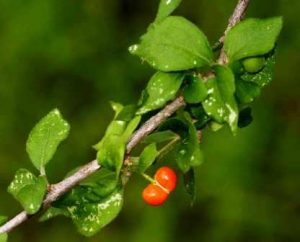
Erythrococca trichogyne. Photo: Bart Wursten. Source: Flora of Zimbabwe
Also in the dense woodland (almost forest) , in the understorey, was Erythrococca trichogyne. This can be a bit anonymous in appearance when it is not fruiting but the leaf shape and general appearance are fairly easy to recognise. Also present was Albizia tanganyicensis, a tree of rocky places, with its striking almost white bark.
On the edge of the woodland grew three interesting species. Firstly the climber Solanecio angulatus with its greyish, pinnatifid leaves and panicles of small yellow flowers was common. I’ve always thought of this as quite rare, but having seen it quite a bit lately, I’m beginning to wonder.
Also sprawling over rocks and other vegetation was a Hippocratea parvifolia. The distinctive flattened pods of this species (in threes) were present as also were tendril-like structures formed by the stems and the very tiny brownish flowers.
Another attractive weed was Catharanthus roseus (the Madagascar periwinkle). This species readily escapes, many at medium and lower altitudes, and may be abundant by roadsides. This is another Apocynaceae but the leaves are opposite in this case.
All in all, it was a very interesting morning’s walk. A return visit at a different time of year would be very nice.
-Mark Hyde
PALMS Extracted from and acknowledged with thanks to the magazine of the Albany Museum. R.S.A.
The Phoenix August 1994. Vol. 7.No 1.
A CAVALCADE OF COCONUTS (Continued). By Estelle Brink
Fill the Horns.
The genus Elaeis has an unusual distribution. It consists of only two species, Elaeis guineensis of tropical West Africa and Elaeis oleifera of the Amazonian lowlands in South America. The name is derived from the Greek word for olive, elaeon, and there is an obvious connection between its bunches of oil-bearing fruits and those of the Mediterranean oleas.
In spite of the vivid visionary imaginations of men like Pharoah Neccho who sent a Phoenician fleet around Africa in 600 BC and the daring exploits of Hanno the Carthaginian in 500 BC who sailed past the Saharan Cape Bojador to the mouth of the Senegal establishing seven trading colonies on the way, Africa remained terra incognito until the time of a new visionary, Prince Henry the Navigator. European man was held in the thrall of a belief that he was destined to be confined to an area between the Northern Frigid Zone and the Torrid Zone, an uninhabited Hell where the sun passed so close to the sea and the land that the former boiled and latter was on fire. This Zone started somewhere around Cape Bojador and their fears were in no way allayed by Hanno’s reports of his sighting of Mt. Cameroun or Kakulimo in the volcanic range at the eastern end of the Gulf of Guinea which he called the chariot of the Gods or the Arab geographers who marked out the Green Sea of Darkness, a fearful area of perpetual fog and contrary currents from which, once entered, there was no return.
It needed a spur. In 1415 an expedition against the Moorish seaport Ceuta was successful and the pirates who have pestered shipping through the Straits of Gibraltar were brought under control. Portugal hoped to take over as a bonus the rich caravan trade in gold dust from the interior of Africa. But this failed and the caravans simply followed another route visiting other Moorish cities. And so there emerged another purpose. To discover for themselves from which parts of Africa the merchandise, particularly the gold dust, emanated.
In 1432 Gil Eannes, Henry’s shield-bearer, broke the spell when he sailed past the sinister coast of Cape Non (where the sea itself is so red with desert sand that tracks of the vessels remain visible for days and the ships themselves are discoloured red) and reached Cape Bojador.
In 1435-36 Afonso Baldaya reached the Rio de Oro just north of Cape Blanco and in 1441 Antao Goncalves made history when he brought back to Lisbon gold dust and a number of Senegalese negro slaves.
The way was opened to a Portuguese empire and a new tribulation was added to the lot of the long-suffering indigenous people of Africa for now they not only had to contend with the long-established Muslim trade in human beings from the interior but had to face the same threat from the Christians who came in from the sea. Our 20th century morality may well cringe in horror at the mention of slavery but we ought to remember that since the dawn of time a large proportion of mankind in every country of the world lived their lives as slaves whether as the utterly rightless servus in the Roman Empire or the serfs who were inherited with the soil in feudal Europe. What made this enslavement so disgusting and abhorrent was the perversion of Christianity that it represented for it was ordered by the Church of Rome as a Crusade and took place under the mantle of the saving of souls from the Infidel.
By 1461 the Grain, Ivory and Gold Coasts had been discovered as far as Elmina just short of Accra and Lagos which later became the oil seaports of Africa. But it was only in 1650 that the botanist Bauhin penned the first accurate description of Elaeis guineensis.
The trunks are up to 10 m high and are coarsely and deeply ringed. The leaves like those of the coconut are pinnately divided into 50 60 leaflets and can be up to 3m long. The flowers are unisexual and are borne on separate inflorescences where they are sunken in deep pits in the branches of the spadices. The fruits are red, about the size of plums and borne in large clusters and the palm oil of commerce is obtained from the fleshy seed coat as well as from the kernel.
The African Oil palm fruit contains 45-48% of palm oil in its fleshy coat and another 56% of palm kernel oil in the endosperm of the seed the whole fruit provides oil. Coconut oil derives only from the kernel. As a tropical tree crop it bears fruit almost continuously in large dense bunches and is not just the most efficient oil producing palm but the most efficient of all the oil-producing plants.
But, until fairly recently, it was exploited only in West Africa from wild or semi-wild trees. About 100 years ago, that most efficient institution for the industrialization of the colonies and the upliftment of its peoples, the Royal Botanic Gardens at Kew, took an interest in this age-old provider of oil used in Africa for everything from butter and cooking fat to the anointing of babies and bodies and, exported for revenue to England, for making soap, candles and for use in South Wales in the preparation of tin plate (the non-drying oil preserved the surface of heated iron sheets from oxidation). Following the active interest of Kew, plantations were planted in Borneo and the species is now cultivated in a broad band across Africa and down its east-coast.
The description of the rural manufacturing process in the Kew Bulletin on 1892 conjures up biblical scenes of whole villages working together. The chief flowering period in Lagos is during the months of September and October. Four or five months later when the cold dry Harmattan blows from the desert, the fruits can be harvested. The waterways fill with flotillas of trading canoes and the lagoon shores glow with fires. Hoarse songs and the shouts of natives at work sound throughout the night. The fruit that was gathered by climbing the trees with a rope harness is piled in a heap and covered with a thin layer of palm, leaves and left for 4-10 days to ferment. When the fruits become loose they are removed by hand and collected in baskets and the oil extraction process can begin.
The first step is boiling for about two hours in large earthenware pots which can hold 11 gallons of water. As soon as the fruits are softened they are strained in baskets and piled into a canoe which has been hauled up out of the water for this purpose. Now the mashing can begin and men stamp heavily to and fro with a curious twisting motion of their feet to separate the pericarp from the kernels. In only 45 minutes three men can process 22 cwt of fruits.
About a third of the length of the canoe is now dammed off, cold water is poured into it and the fibre is swished around, separated from the kernels, thoroughly squeezed and thrown aside into baskets. All this time water is ladled up and poured rapidly from a height out of calabashes into the canoe and the remaining fibre is separated from the kernels and sieved out by sidelong blows of a small basket. Soon the water becomes covered in a greenish yellow scum containing the oil which is skimmed off into floating calabashes. The fibre that has been removed is beaten in a mortar and washed again after which it is pressed into balls and dried for use as tinder.
The kernels that remain behind are also loaded into baskets to be dried in the sun before cracking to provide the palm kernels that are exported.
The crude oil obtained from the pericarp is clarified by boiling during which time it is kept in constant motion by passing a small basket back and forth to catch all the remaining fragments of fibre. After about half an hour the oil turns blood-red and can be skimmed off. The skimming is repeated a number of times before the oil is poured into five-gallon jars for marketing.
From beginning to end this clarifying process takes 8 14 hours. People begin working at about 4 o’clock in the afternoon and continue all through the night and into the cool hours of morning.
Alvan Millson, Assistant Colonial Secretary in Lagos in 1892 who reported this process for the Kew Bulletin, calculated that to produce the 3 million gallons of palm oil annually exported from Lagos, 150 000 tonnes of palm nuts were gathered each year from 15 million trees.
As this process lends itself to mechanisation, each plantation has benefitted by having its own processing plant and it is no wonder that W G Hodge could report in Principes of October 1975 that the world exports of coconut oil in the decade 1962-1972 increased only by 16% while that of Elaeis oils leapt ahead at a 75% increase.
The other species, Elaeis oleifera (the oil-bearing Elaeis) of South and Central America has not had the same horticultural attention and is still exploited only from wild stands. However, it has oleaginous characteristics very similar to the African oil palm and would no doubt be as great a provider of revenue to those countries.
Ex Africa Semper Aliquid Novi
The dwarf Pondoland palm, Jubaeopsis caffra, is the only member of the coconut tribe that grows naturally in South Africa. It is found in a very confined area from the mouths to about 5 km inland of the Mtentu and the Msikaba rivers which are only 10 kms apart. It was given a name as recently as 1913 although specimens have been found in Kew and in the National Herbarium (under other names) dated 1898 and 1899 respectively. Its nearest relative is a Chilean palm, Jubaea chilensis and this little palm is clothed in mystery. It has been accepted that it is a true endemic to Pondoland but there is a legend about unknown explorers from the East having brought it here many centuries ago.
The trees are single stemmed to start with but soon become multi-stemmed like out Phoenix reclinata and are seldom over 5m in height. The leaves, like those of the preceding two species, are pinnate with A-folded leaflets which distinguishes it clearly from the V-folded Phoenix reclinata leaflets.(roofs and gutters a la Kim Damstra) They can be up to 4 m long and arch gracefully over the flowing rivers. The flowers are male and female and are arranged in triads with two lateral male flowers for each female flower. The fruits are only about 3 cms in diameter but resemble the large coconut in almost every detail with a fibrous coir covering and a thin white layer of endosperm surrounding the central cavity which contains a sip of coconut milk. It is relished by children but has no other real uses which is just as well as so small a population would have been wiped out long ago if treated in the way Raphia and Hyphaene, the wine palms, are treated. The Transkei Nature Conservation Act has conferred protection on it and part of the colony occurs in the Mkambati Nature Reserve.
The name Jubaeopsis relates it to Jubaea which honours our old friend King Juba of Mauritania who named Euphorbia. Jubaea chilensis is a tremendously robust palm known to have the thickest of all palm trunks. Two specimens can be seen in the town of Uitenhage where they make spectacular feature trees. In Chile the fruits which are very similar to those of Jubaeopsis are called coquitos or little coconuts. Jubaeopsis is known commonly as Pondo Coconut, Dwarf Coconut or inKomba.
Worldwide there are many more Cocosoid genera of palms many of them providing useful products such as Attalea junifera, Bahia piassave, which is grown for the round, stiff bristle fibre used in brooms which is obtained from the leaf-bases. Its nuts are called coquilla nuts and they are widely used in turnery for the handles of bell-pulls and umbrellas and also for buttons.
But Cocos and Elaeis are hard to beat in their service to mankind and this is one of the strongest factors which gives the Arecaceae (Palmae), as a family, their proud place second only to the grain plants (Poaceae or Gramineae) in economic importance in the world
MARK HYDE CHAIRMAN


